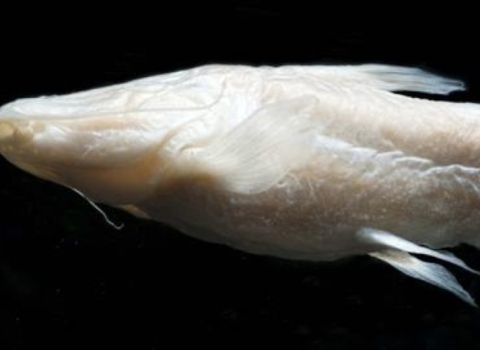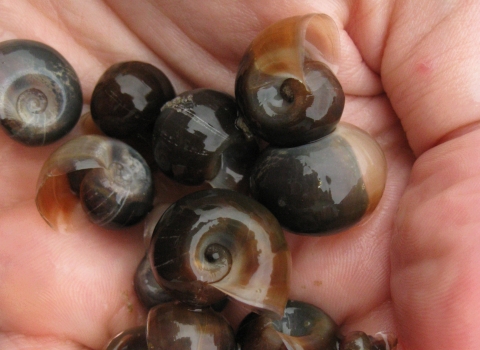FALLS CHURCH, Va. – The U.S. Fish and Wildlife Service has completed its 90-day findings on petitions to list 10 species under the Endangered Species Act. Based on the Service’s review, the petitions to list the betta hendra, betta rutilans, Hickory Nut Gorge green salamander, pygmy rabbit, Railroad Valley toad, Southern Plains bumble bee, southwest spring firefly, white-margined penstemon, and yellow-spotted woodland salamander contain substantial information that listing may be warranted, and status reviews will be initiated on these species.
In addition, the Service finds the petition to list the eastern hellbender does not present substantial information indicating the petitioned action may be warranted. The Service will not initiate a status review of this species.
Warranted Petitions:
Betta hendra — A colorful freshwater fish endemic to the peat swamp forests of Central Kalimantan, Indonesian Borneo.
Betta rutilans — A red-colored freshwater fish endemic to the peat swamp forests of West Kalimantan, Indonesian Borneo.
Hickory Nut Gorge green salamander — An amphibian with a dark body and bright green to yellow patches on its back. It is found in the hardwood and cove forests in Hickory Nut Gorge in western North Carolina and was first described as a unique species in 2019.
Pygmy rabbit – A small rabbit that lives in a sagebrush sagebrush
The western United States’ sagebrush country encompasses over 175 million acres of public and private lands. The sagebrush landscape provides many benefits to our rural economies and communities, and it serves as crucial habitat for a diversity of wildlife, including the iconic greater sage-grouse and over 350 other species.
Learn more about sagebrush habitat. It is found in the Great Basin and adjacent intermountain areas of the western United States, from southeastern Oregon and southern Idaho to southwestern Montana and south-central Wyoming to northwestern Colorado and southwestern Utah, central Nevada, and eastern California.
Railroad Valley toad — One of the smallest of the western toad species with a long head and limbs and dark brown spots. It lives only in the spring-fed wetlands in the Lockes Wildlife Management Area in Nye County, Nevada.
Southern Plains bumble bee — A large black and yellow bumble bee identified by its short hair, short head and typically yellow coloring between the head and thorax, between the wings. The species inhabits open prairies, meadows and grasslands of the Midwest, mid-Atlantic states, and the Plains states from Texas to North Dakota, as well as to the grasslands and pine savannas of Florida and the southeast.
Southwest spring firefly —A terrestrial invertebrate native to Arizona and associated with riparian riparian
Definition of riparian habitat or riparian areas.
Learn more about riparian and wetland habitats. Primary threats to fireflies include potential habitat destruction from alteration or loss of ground and surface water flows, livestock grazing, mining, effects from climate change climate change
Climate change includes both global warming driven by human-induced emissions of greenhouse gases and the resulting large-scale shifts in weather patterns. Though there have been previous periods of climatic change, since the mid-20th century humans have had an unprecedented impact on Earth's climate system and caused change on a global scale.
Learn more about climate change , and light pollution.
White-margined penstemon — A rare perennial plant restricted to the Mojave Desert, with four disjunct populations in southeastern California, southern Nevada, and northwestern Arizona. It is 15-35 cm tall, with smooth stems and pink to purple petals.
Yellow-spotted woodland salamander — A large, slender salamander with a gray-brown body and two rows of yellow spots along its back. It inhabits steep shale and sandstone outcroppings along the Appalachian Plateau in Kentucky, Tennessee, Virginia and West Virginia.
Not Warranted Petition:
Eastern hellbender — A large, aquatic salamander that occurs in cool, permanent streams across 15 states. In 2021, the Service listed the Missouri distinct population of eastern hellbender as endangered.
The Federal Register docket numbers and links for the petition findings in this batch are:
| Common Name | Range | Docket Number | Docket link onhttps://www.regulations.gov |
| Betta hendra | Central Kalimantan, Borneo, Indonesia | FWS-HQ-ES-2023-0152 | https://www.regulations.gov/docket/FWS-HQ-ES-2023-0152/document |
| Betta rutilans | Kalimantan Barat (West Kalimantan), Borneo, Indonesia | FWS-HQ-ES-2023-0153 | https://www.regulations.gov/docket/FWS-HQ-ES-2023-0153/document |
| Hickory Nut Gorge green salamander | NC | FWS-R4-ES-2023-0139 | https://www.regulations.gov/docket/FWS-R4-ES-2023-0139/document |
| Pygmy rabbit | CA, CO, ID, MT, NV, OR, UT, WY | FWS-R8-ES-2023-0146 | https://www.regulations.gov/docket/FWS-R8-ES-2023-0146/document |
| Railroad Valley Toad | Nye County, NV | FWS-R8-ES-2023-0142 | https://www.regulations.gov/docket/FWS-R8-ES-2023-0142/document |
| Southern Plains bumble bee | AL, AR, CA, CO, FL, GA, IL, IA, KS, KY, LA, MS, MO, NE, NM, ND, OH, OK, SC, SD, TN, TX, VA, WY | FWS-R3-ES-2023-0137 | https://www.regulations.gov/docket/FWS-R3-ES-2023-0137/document |
| Southwest spring firefly | AZ, NM, Mexico | FWS-R2-ES-2023-0136 | https://www.regulations.gov/docket/FWS-R2-ES-2023-0136/document |
| White-margined penstemon | NV, AZ, CA | FWS-R8-ES-2023-0141 | https://www.regulations.gov/docket/FWS-R8-ES-2023-0141/document |
| Yellow-spotted woodland salamander | KY, TN, VA, WV | FWS-R5-ES-2023-0140 | https://www.regulations.gov/docket/FWS-R5-ES-2023-0140/document |
| Eastern hellbender | AL, GA, IL, IN, KY, MD, MS, NY, NC, OH, PA, TN, VA, WV | FWS-R3-ES-2023-0138 | https://www.regulations.gov/docket/FWS-R3-ES-2023-0138/document |
The notice for the above findings will be available in the Federal Register Reading Room on Wednesday, Jan. 24 at https://www.federalregister.gov/public-inspection/current. The above findings will be published in the Federal Register on Thursday, Jan. 25.
For more information on the ESA listing process, including 90-day findings and status reviews, please go to https://www.fws.gov/media/listing-species-threatened-or-endangered
-FWS-
The U.S. Fish and Wildlife Service works with others to conserve, protect and enhance fish, wildlife, plants and their habitats for the continuing benefit of the American people. For more information, visit www.fws.gov and connect with us on social media: Facebook, Instagram, X (formerly known as Twitter), LinkedIn, Flickr and YouTube.


